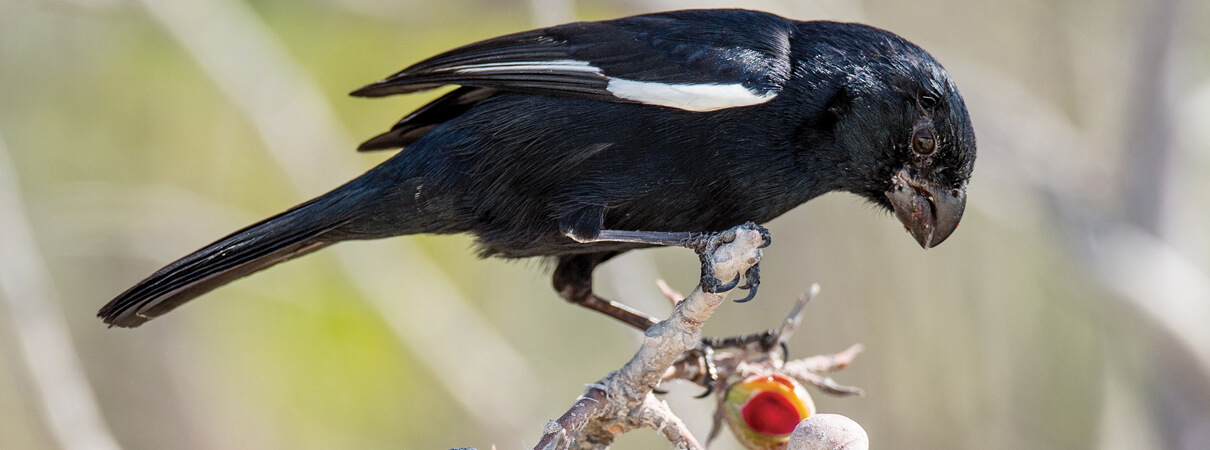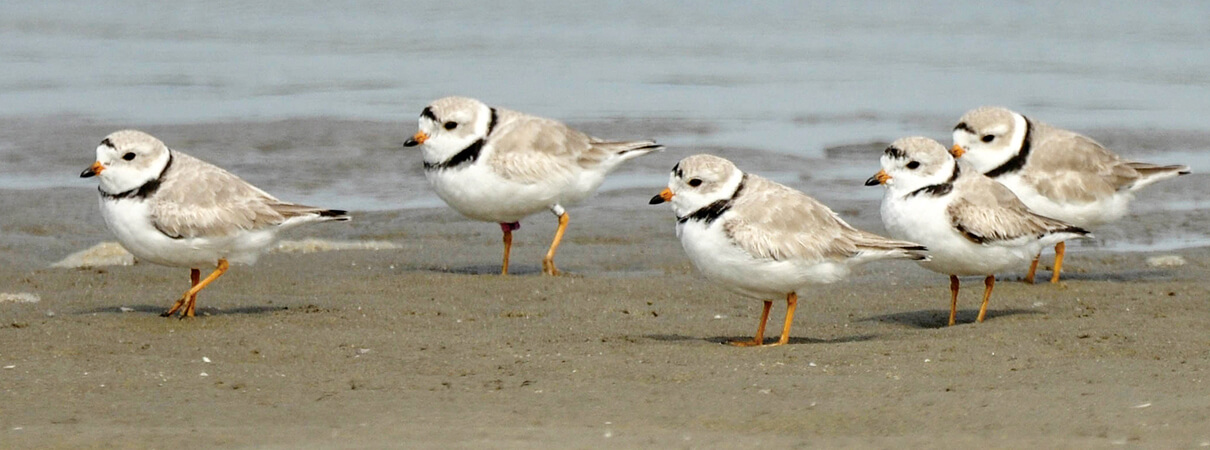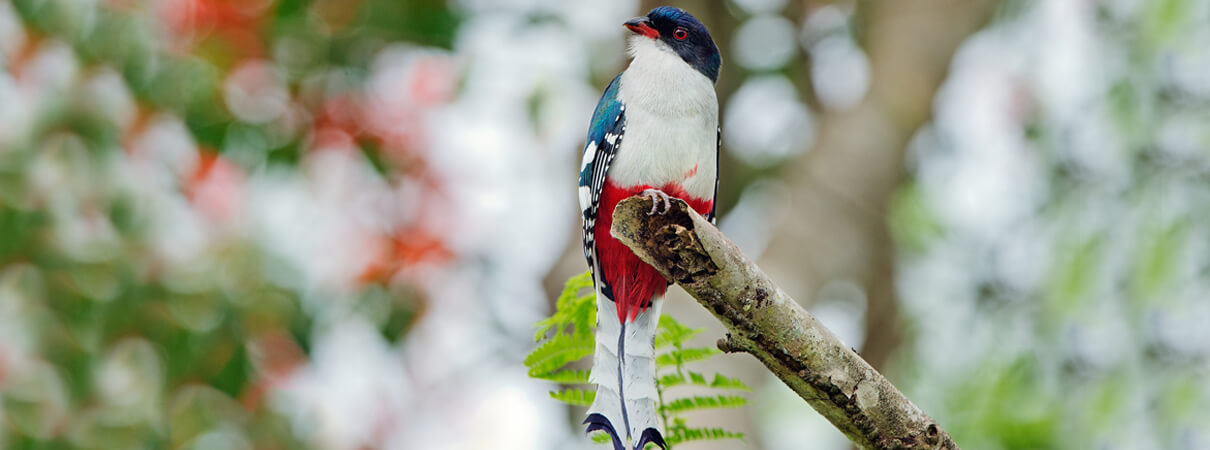Cuba Welcomes Migratory Birds (and Ecotourists)
In late summer and early autumn, the skies above Cuba become flyways for hundreds of thousands of migratory birds flying from their breeding grounds to points south. Cuba is the largest island in the Caribbean region, and its vast expanses of mountains, forests, wetlands, and low-lying coastal islands (known as cays, or cayos) make the country an important stopover site for migrating birds.

The Black-throated Blue Warbler is among the many bird species that breed in North America and winter in Cuba and other sites throughout the Caribbean. Photo by Paul Jones
Cuba boasts 373 species of birds, most of them migratory; 26 are found nowhere else on the planet. Arturo Kirkconnell, Curator of Ornithology of the National Museum of Natural History in Cuba and author of A Field Guide to the Birds of Cuba, has spent most of his career as an ornithologist studying the island's birds. He also has led birding tours for nearly three decades.
Now that diplomatic relations between the United States and Cuba are warming and the country is welcoming more visitors from the U.S., many conservationists are wondering: What will be the impact on Cuba's wildlife? We asked Kirkconnell to tell us more about Cuba's birds, and what Americans can do to support ecotourism and conservation across the island.
ABC's Libby Sander: How did you become interested in birds?
Arturo Kirkconnell: When I started my career, I had studied mostly invertebrates—mainly land snails. Then I asked a friend and colleague who studied birds to teach me about them. The first two birds I saw were Northern Parula and American Redstart, and this was enough. I was hooked. Some Cuban land snails are very colorful creatures, but nothing like birds. Their behavior, their calls, and their beauty—what else I could ask for?
In my first year as a birder I was without binoculars, just watching with my eyes, till I got my first pair of old, heavy Russian binoculars!

The Cuban Bullfinch is found only on Cuba and Grand Cayman. Although the species is not considered threatened, it is increasingly impacted by illegal collection for the pet trade. Photo by Sergey Uryadnikov/Shutterstock
LS: Where is your favorite place to go birding—and lead birding tours—in Cuba?
AK: My favorite place is the Zapata Peninsula, where you can see the greatest diversity of birds, about 260 species, and about 87 percent of Cuban endemic birds. The main goal of my tours is to watch the endemics and enjoy their beauty, but also to watch the many other colorful permanent residents and of course migratory birds, too. My field slogan is, enjoy the birds!
LS: Why is Cuba so important for migratory birds?
AK: Accounting for approximately half of all of the land in the West Indies, Cuba is also located immediately south of Florida and east of the Yucatan Peninsula. So it has huge areas of suitable wintering and stopover habitat right at the crossroads of major migration pathways.

Cuba is the most important wintering ground for Piping Plovers and several other migratory birds. Photo by Ed Konrad
For some migratory species, Cuba is their major wintering ground. For Palm Warbler, Black-throated Blue Warbler, and Piping Plover, Cuba is the most important winter quarters in the West Indies. Other migratory species that regularly winter in Cuba are American Redstart, Northern Parula, Black-and-white Warbler, Common Yellowthroat, Cape May Warbler, Prairie Warbler, and Indigo Bunting, among others. Bachman's Warbler, now believed to be extinct, wintered only here.
About a dozen neotropical species come to Cuba from southern regions to breed, too, including Black-whiskered Vireo and Greater Antillean Nighthawk.
LS: What are some of the most important landscapes for migratory birds in Cuba?
AK: Migratory birds occur in many different habitats. Landbirds—such as many species of warblers and vireos—are more abundant in semi-deciduous, evergreen, and swampy forests, and in dry coastal scrub.
Among the most important bird habitats are natural wetlands. Shorebirds, herons, and ducks make up the largest percentage of migrants in these aquatic ecosystems, which in Cuba include beach and coastline, mangroves, marshes, lakes, and reservoirs. Most mudflats are in the southern part of the Cuban archipelago, including Zapata Swamp.
Most of the large cays are crucial wintering grounds for nearctic waders [waders that nest in the United States or Canada and migrate south for the winter] and are important stopover sites for passage migrants as well. Rice fields are spectacular feeding sites for birds where many species gather in great numbers.
LS: Cuba has dozens of bird species that occur nowhere else in the world. Describe a few of these endemic birds for us.
AK: The Blue-headed Quail-Dove is a very beautiful bird, and is rare and vulnerable. It is a ground dweller found in the dense forest. The Cuban Tody is another striking endemic and is common throughout Cuba. This bird emits a rattling sound with its wings in flight, which helps you find it among the green foliage. The Cuban Trogon is the country's national bird, because its colors match the Cuban flag. And the Bee Hummingbird is the world's smallest bird. Males like to sing in the highest bare twigs while flashing their red-pink gorgets to other males and females.

The Cuban Trogon is the country's national bird because its colors match those of the Cuban flag. Photo by Sergey Uryadnikov/Shutterstock
LS: What conservation threats do Cuban birds face?
AK: Habitat destruction, hunting, the introduction of exotic species, and illegal cage bird trade all have an adverse impact on Cuba's birds and their habitats.
The northern cays are among the most disturbed areas, mainly as a result of development for tourism. In these cays a few species occur only in small numbers and are therefore highly threatened, including the Bahama Mockingbird, Thick-billed Vireo, and Zapata Sparrow.
For sport hunting, there are official regulations regarding species, seasons, places, and bag limits, but both hunters and wardens frequently disregard these. Poachers persistently violate official restrictions and use not only guns but also several kinds of traps. The Blue-winged Teal and West Indian Whistling-Duck are among the species that are vulnerable to hunting and poaching.
Like other islands in the Antilles, Cuba is plagued by the accidental and intentional introduction of non-native species. Rats, feral pigs, cats, and dogs are now in the most remote and virgin forests, along with the mongoose. Walking catfish are the worst of all—a real ecological disaster. They have spread into many lakes and rivers in Cuba. In Zapata Swamp, they are eating everything, including native waterbirds, probably including the critically endangered Zapata Rail.
LS: As you mentioned, the domestic cage bird trade in Cuba is a major threat for birds. Tell us more about that.
AK: The Cuban Parrot is the species most affected by illegal commerce. Chicks are taken from the wild by felling their nesting trees and then reared by hand until they are fully developed. No doubt hundreds have been smuggled out of the country in a drugged state, simply hidden inside the pockets of travelers. Other species known to have been smuggled out of the country are the Cuban Grassquit, Cuban Bullfinch, and Cuban Parakeet.

Illegal collection for the pet trade impacts several of Cuba's bird species, including the Cuban Parrot shown here. Photo by Elliotte Rusty Harold/Shutterstock
The cage bird trade has become a way of life for some people. Several thousand birds are captured every year on the island, including the Painted Bunting, which is one of the most-wanted cage birds because of its beauty. This is a huge problem, and I do not see a solution in the near future to stop it.
LS: As Cuba begins to welcome more visitors from the U.S., what challenges and opportunities does this present for bird conservation?
AK: More visitors will bring more development, and more development will result in habitat destruction in pristine areas like the cays surrounding Cuba's mainland. Protecting these places is a big challenge for all conservation institutions and organizations. One of the species most affected is the Piping Plover, which likes quiet, pristine beaches as its wintering grounds. The number of Piping Plovers wintering in the cays is declining dramatically, undoubtedly due to human disturbance.
LS: Given the limitations under the ongoing embargo, how can people in the U.S. or U.S.-based organizations help Cubans with bird conservation?
AK: There are several ways to help. For starters, visiting the island will help to develop ecotourism and will encourage international conservation organizations and people to support bird conservation in Cuba. Supporting environmental education and crafting environmental agreements between both countries will help to minimize damage to bird habitats and stop the commercial trade of migratory and endemic species.
Also helpful would be providing funding and technology to try to eradicate invasive species, and cooperating in projects to recover the rarest and threatened bird species. Finally, by joining expeditions to study the natural history of Cuban birds, Americans can support bird conservation and help to develop Cuban science.
LS: This might be an unfair question, but do you have a favorite Cuban bird?
AK: My favorite bird is the Cuban Tody (Todus multicolor). It is easy to guess why—just take a look at its scientific name!

The brilliantly colored Cuban Tody is endemic to Cuba and a few of its coastal islands. Photo by Arturo Kirkconnell
For more information on Arturo Kirkconnell's birding tours in Cuba, visit kirkconnellbirds.com or send him an email: a.kirkconnell59@gmail.com.
Editor's note: This article first appeared in the fall 2016 edition of Bird Conservation magazine.
With your support, we can better protect the places that migratory birds need to survive. Click here to donate.
 Libby Sander is Senior Writer and Editor at American Bird Conservancy. Before coming to ABC in 2015, she spent 13 years as a journalist, writing news stories and award-winning features for The New York Times, the Washington Post, and The Chronicle of Higher Education. You can follow her on Twitter at @libsander.
Libby Sander is Senior Writer and Editor at American Bird Conservancy. Before coming to ABC in 2015, she spent 13 years as a journalist, writing news stories and award-winning features for The New York Times, the Washington Post, and The Chronicle of Higher Education. You can follow her on Twitter at @libsander.


















































